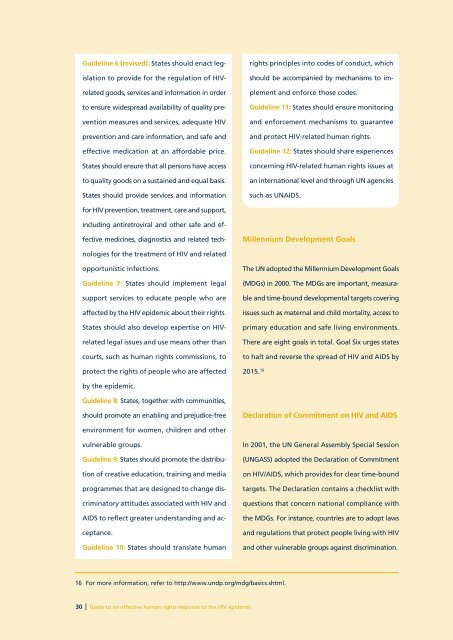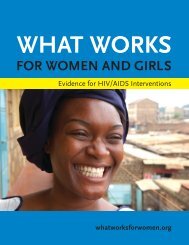Guide to an effective human rights response to the HIV epidemic
Guide to an effective human rights response to the HIV epidemic
Guide to an effective human rights response to the HIV epidemic
Create successful ePaper yourself
Turn your PDF publications into a flip-book with our unique Google optimized e-Paper software.
<strong>Guide</strong>line 6 (revised): States should enact legislation<br />
<strong>to</strong> provide for <strong>the</strong> regulation of <strong>HIV</strong>related<br />
goods, services <strong>an</strong>d information in order<br />
<strong>to</strong> ensure widespread availability of quality prevention<br />
measures <strong>an</strong>d services, adequate <strong>HIV</strong><br />
prevention <strong>an</strong>d care information, <strong>an</strong>d safe <strong>an</strong>d<br />
<strong>effective</strong> medication at <strong>an</strong> affordable price.<br />
States should ensure that all persons have access<br />
<strong>to</strong> quality goods on a sustained <strong>an</strong>d equal basis.<br />
States should provide services <strong>an</strong>d information<br />
<strong>rights</strong> principles in<strong>to</strong> codes of conduct, which<br />
should be accomp<strong>an</strong>ied by mech<strong>an</strong>isms <strong>to</strong> implement<br />
<strong>an</strong>d enforce those codes.<br />
<strong>Guide</strong>line 11: States should ensure moni<strong>to</strong>ring<br />
<strong>an</strong>d enforcement mech<strong>an</strong>isms <strong>to</strong> guar<strong>an</strong>tee<br />
<strong>an</strong>d protect <strong>HIV</strong>-related hum<strong>an</strong> <strong>rights</strong>.<br />
<strong>Guide</strong>line 12: States should share experiences<br />
concerning <strong>HIV</strong>-related hum<strong>an</strong> <strong>rights</strong> issues at<br />
<strong>an</strong> international level <strong>an</strong>d through UN agencies<br />
such as UNAIDS.<br />
for <strong>HIV</strong> prevention, treatment, care <strong>an</strong>d support,<br />
Millennium Development Goals<br />
including <strong>an</strong>tiretroviral <strong>an</strong>d o<strong>the</strong>r safe <strong>an</strong>d <strong>effective</strong><br />
medicines, diagnostics <strong>an</strong>d related technologies<br />
for <strong>the</strong> treatment of <strong>HIV</strong> <strong>an</strong>d related<br />
opportunistic infections.<br />
<strong>Guide</strong>line 7: States should implement legal<br />
support services <strong>to</strong> educate people who are<br />
affected by <strong>the</strong> <strong>HIV</strong> <strong>epidemic</strong> about <strong>the</strong>ir <strong>rights</strong>.<br />
States should also develop expertise on <strong>HIV</strong>related<br />
legal issues <strong>an</strong>d use me<strong>an</strong>s o<strong>the</strong>r th<strong>an</strong><br />
courts, such as hum<strong>an</strong> <strong>rights</strong> commissions, <strong>to</strong><br />
protect <strong>the</strong> <strong>rights</strong> of people who are affected<br />
The UN adopted <strong>the</strong> Millennium Development Goals<br />
(MDGs) in 2000. The MDGs are import<strong>an</strong>t, measurable<br />
<strong>an</strong>d time-bound developmental targets covering<br />
issues such as maternal <strong>an</strong>d child mortality, access <strong>to</strong><br />
primary education <strong>an</strong>d safe living environments.<br />
There are eight goals in <strong>to</strong>tal. Goal Six urges states<br />
<strong>to</strong> halt <strong>an</strong>d reverse <strong>the</strong> spread of <strong>HIV</strong> <strong>an</strong>d AIDS by<br />
2015. 16<br />
by <strong>the</strong> <strong>epidemic</strong>.<br />
<strong>Guide</strong>line 8: States, <strong>to</strong>ge<strong>the</strong>r with communities,<br />
should promote <strong>an</strong> enabling <strong>an</strong>d prejudice-free<br />
Declaration of Commitment on <strong>HIV</strong> <strong>an</strong>d AIDS<br />
environment for women, children <strong>an</strong>d o<strong>the</strong>r<br />
vulnerable groups.<br />
<strong>Guide</strong>line 9: States should promote <strong>the</strong> distribution<br />
of creative education, training <strong>an</strong>d media<br />
programmes that are designed <strong>to</strong> ch<strong>an</strong>ge discrimina<strong>to</strong>ry<br />
attitudes associated with <strong>HIV</strong> <strong>an</strong>d<br />
AIDS <strong>to</strong> reflect greater underst<strong>an</strong>ding <strong>an</strong>d accept<strong>an</strong>ce.<br />
<strong>Guide</strong>line 10: States should tr<strong>an</strong>slate hum<strong>an</strong><br />
In 2001, <strong>the</strong> UN General Assembly Special Session<br />
(UNGASS) adopted <strong>the</strong> Declaration of Commitment<br />
on <strong>HIV</strong>/AIDS, which provides for clear time-bound<br />
targets. The Declaration contains a checklist with<br />
questions that concern national compli<strong>an</strong>ce with<br />
<strong>the</strong> MDGs. For inst<strong>an</strong>ce, countries are <strong>to</strong> adopt laws<br />
<strong>an</strong>d regulations that protect people living with <strong>HIV</strong><br />
<strong>an</strong>d o<strong>the</strong>r vulnerable groups against discrimination.<br />
16 For more information, refer <strong>to</strong> http://www.undp.org/mdg/basics.shtml.<br />
30 | <strong>Guide</strong> <strong>to</strong> <strong>an</strong> <strong>effective</strong> hum<strong>an</strong> <strong>rights</strong> <strong>response</strong> <strong>to</strong> <strong>the</strong> <strong>HIV</strong> <strong>epidemic</strong>

















